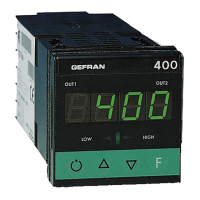13
81503D_MHW_400-401_12-2010_ENG
6 • ALARMS
Proportional Action:
action in which contribution to output is proportional to deviation at input (deviation = difference between controlled variable and
setpoint).
Derivative Action:
action in which contribution to output is proportional to rate of variation input deviation.
Integral Action:
action in which contribution to output is proportional to integral of time of input deviation.
Influence of Proportional, Derivative and Integral actions on response of process under control
* An increase in P.B. reduces oscillations but increases deviation.
* A reduction in P.B. reduces the deviation but provokes oscillations of the controlled variable (the system tends to be unstable
if P.B. value is too low).
* An increase in Derivative Action corresponds to an increase in Derivative Time, reduces deviation and prevents oscillation up
to a critical value of Derivative Time, beyond which deviation increases and prolonged oscillations occur.
* An increase in Integral Action corresponds to a reduction in Integral Time, and tends to eliminate deviation between the
controlled variable and the setpoint when the system is running at rated speed.
If the Integral Time value is too long (Weak integral action), deviation between the controlled variable and the setpoint may
persist.
Contact GEFRAN for more information on control actions.
7 • CONTROL ACTIONS
time
AL1 + Hyst1
AL2 + Hyst2
AL2
AL1
alarm 1
alarm 2
(*)
For AL1 = reverse absolute alarm (low) with positive Hyst1, AL1 t = 1
(*) = OFF if disabled on power-up
For AL2 = direct absolute alarm (high) with negative Hyst2, AL2 t = 0
Normal absolute alarm
For AL1 = symmetrical Lo absolute alarm with Hyst1, AL1 t = 5
For AL1 = symmetrical Hi absolute alarm with Hyst1, AL1 t = 4
* Minimum hysteresis = 2 scale points
Symmetrical absolute alarm
reverse alarm
direct alarm
AL1
AL1 + [ Hyst1 * ]
AL1 - [ Hyst1* ]
time
For AL1 = Lo deviation alarm with negative Hyst 1, AL1 t = 3
For AL1 = Hi deviation alarm with negative Hyst 1, AL1 t = 2
SP+AL1
SP
reverse
alarm
direct
alarm
time
Hyst1
Deviation alarm
For AL1 = Symmetrical Lo deviation alarm with Hyst 1, AL1 t = 7
For AL1 = Symmetrical Hi deviation alarm with Hyst 1, AL1 t = 6
time
SP+AL1
SP
reverse alarm
direct alarm
Symmetrical deviation Alarm
SP-AL1

